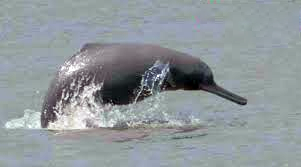Biodiversity & Environment
Ganges River Dolphin
- 03 Nov 2021
- 4 min read
Why in News
Recently, the Ministry of Jal Shakti released a guide for the safe rescue and release of stranded Ganges River Dolphins.
- The document has been prepared by the Turtle Survival Alliance and the Environment, Forest and Climate Change Department (EFCCD) of the Uttar Pradesh Government.
- It was recognised as the National Aquatic Animal in 2009, by the Government of India.
Key Points
- Scientific Name:Platanista gangetica gangetica.

- Discovery: It was officially discovered in 1801.
- Habitat: They live in the Ganges-Brahmaputra-Meghna and Karnaphuli-Sangu river systems of Nepal, India, and Bangladesh.
- The Ganges river dolphin can only live in freshwater and is essentially blind.
- They hunt by emitting ultrasonic sounds, which bounces off of fish and other prey, enabling them to “see” an image in their mind. They are also called ‘susu’.
- Population: The global population of the species is estimated at 4,000, and nearly 80% found in the Indian subcontinent.
- Significance:
- It is a reliable indicator of the health of the entire river ecosystem.
- Threats:
- Bycatch: These dolphins and people both favor areas of the river where fish are plentiful and the water current is slower. This has led to fewer fish for people and more dolphins dying as a result of accidentally being caught in fishing nets, also known as bycatch.
- Pollution: Industrial, agricultural, and human pollution is another serious cause of habitat degradation.
- Dams: Construction of dams and other irrigation-related projects make them susceptible to inbreeding and more vulnerable to other threats because they cannot move to new areas.
- Dolphins below a dam are threatened by heavy pollution, increased fishing activities and vessel traffic. They also have less food because dams disturb the migration, breeding cycles and habitat of fish and other prey.
- Conservation Status:
- Indian Wildlife (Protection), Act 1972: Schedule I.
- International Union for the Conservation of Nature (IUCN): Endangered.
- Convention on International Trade in Endangered Species (CITES): Appendix I (most endangered).
- Convention on Migratory Species (CMS): Appendix II (migratory species that need conservation and management or would significantly benefit from international co-operation).
- Steps Taken:
- Project Dolphin: The Prime Minister announced the government’s plan to launch a Project Dolphin in his Independence Day Speech 2020. It is on the lines of Project Tiger, which has helped increase the tiger population.
- Dolphin Sanctuary: Vikramshila Ganges Dolphin Sanctuary has been established in Bihar.
- National Ganga River Dolphin Day: The National Mission for Clean Ganga celebrates 5th October as National Ganga River Dolphin Day.
- Conservation Plan: The Conservation Action Plan for the Ganges River Dolphin 2010-2020, which “identified threats to Gangetic Dolphins and impact of river traffic, irrigation canals and depletion of prey-base on Dolphins populations”.




